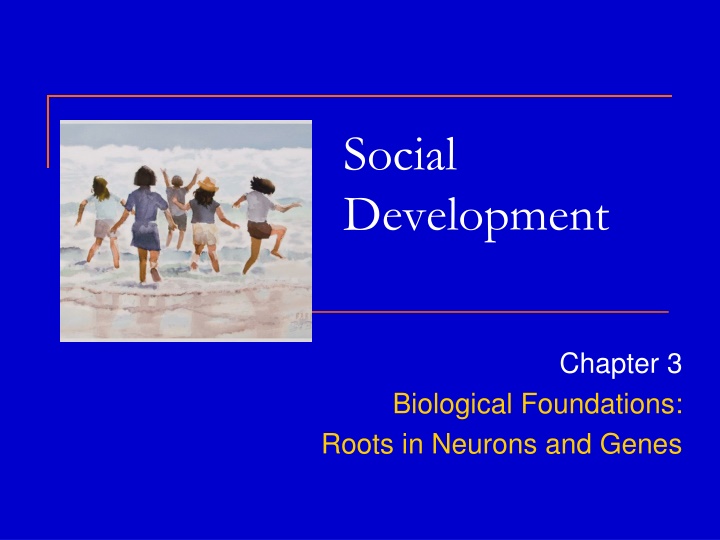Biological Foundations of Social Interaction
Biological foundations of social interaction delve into the roots in neurons and genes, exploring how infants are biologically prepared for social interactions crucial to their development. This chapter covers topics such as evolutionary theory, parent-child synchrony, sensory preparedness, and the long-term effects of synchrony on development. Understand the underlying causes of synchrony and its impact on behaviors and attachment.
Download Presentation

Please find below an Image/Link to download the presentation.
The content on the website is provided AS IS for your information and personal use only. It may not be sold, licensed, or shared on other websites without obtaining consent from the author.If you encounter any issues during the download, it is possible that the publisher has removed the file from their server.
You are allowed to download the files provided on this website for personal or commercial use, subject to the condition that they are used lawfully. All files are the property of their respective owners.
The content on the website is provided AS IS for your information and personal use only. It may not be sold, licensed, or shared on other websites without obtaining consent from the author.
E N D
Presentation Transcript
Social Development Chapter 3 Biological Foundations: Roots in Neurons and Genes
Todays Outline: Biological Foundations of Social Interaction Biological preparedness for social interaction Neurological foundations Genetics Differences in temperament
Biological Preparedness for Social Interaction: Why are babies prepared? Evolutionary Theory Preparedness is adaptive and useful for ensuring the survival of the human infant and more generally, the species Infants are biologically programmed for social interactions that ensure that their needs are met Interactions with environment and people help to develop brain and neuron networks, crucial to later development
Biological Preparedness for Social Interaction: How are babies prepared? Parent-child synchrony Visual Preparedness Auditory Preparedness Smell, Taste, and Touch Preparedness
What is synchrony? a process that coordinates the ongoing exchanges b/w parent and child during social interactions Includes sensory, hormonal, and physiological stimuli Occurs from gestation through infancy Video
Synchrony Newborns: Newborns alert-scanning behavior Maternal behaviors infant-mother and infant-father synchrony at 3 months 3 Months: Begin to respond to social cues Dyadic example Triadic example
Underlying Causes of Synchrony Infant s Biological Rhythms Biological Clock Cardiac Rhythms Mother s Level of Oxytocin Parents activation in brain areas linked to parenting, empathy, and emotion regulation
Long-Term Effects of Synchrony on Development Mother-infant synchrony at 3 and 9 mos Self-regulation behaviors at 2, 4, and 6 years old IQ at 2 and 4 years old Ability to use words that reflect internal states Synchrony with both parents at 3 mos Secure attachment at 1 year Fewer behavior problems at age 2 Greater empathy at age 13
Whos at risk for low synchrony? Prematurely born infants Triplets Infants of clinically depressed mothers Infants of clinically anxious mothers
Interventions Kangaroo Care (KC) Skin-to-Skin Contact 3-month old preterm infants and parents received KC; coded for touch, proximity KC families (Feldman et al., 2003) Parents were more sensitive, less intrusive Infants showed less negative emotion Greater touch and closer proximity among triad Massage (Field, 2001) Greater weight gain, fewer time spent in hospital
Visual preparation for social interaction Fusiform Face Area (FFA; Kanwisher s work) Domain-Specific vs. Domain General
Visual preparation for social interaction Fusiform Face Area (FFA; Kanwisher s work) Domain-Specific vs. Domain General Evidence for importance of FFA in develop. In same location across all subjects Damage to fusiform gyrus at 1-day old Replicated in two monkeys (Tsao)
Auditory Preparation In utero 16 weeks recognizes mother s voice 20-24 weeks recognizes father s voice At 24 weeks Ear now fully developed Preference for music After 24 weeks Respond to readings (Cat in the Hat Study) In infancy Show preferences for in utero music and readings
Auditory Preparation In utero The Cat in the Hat Study (DeCasper & Spence, 1986) At 7.5 months pregnant, mothers recorded two stories The Cat in the Hat and Dog in the Fog RA to one of 3 groups Read Cat in Hat Read Dog in Fog Control no reading Results: Faster sucking to recognized story Sing and read to your babies, but never use headphones or rap music!!
Smells Mothers recognize babies Mothers smelled undershirt of her baby and 2 stranger babies 3 Groups: Time exposed to infant 10 minutes or less (20% recognized) 10 minutes 1 hour (90% recognized) More than 1 hour (100% recognized) Most identified within 30 sec of sniff! Replicated with dirty diapers
Smells Babies and Fathers Newborns Prefer clothing worn by mother (vs. stranger) Breast-fed (vs. bottle-fed) recognize mother s scent earlier Fathers Some evidence that fathers recognize infant by smell and touch But newborns have trouble identifying father by smell























